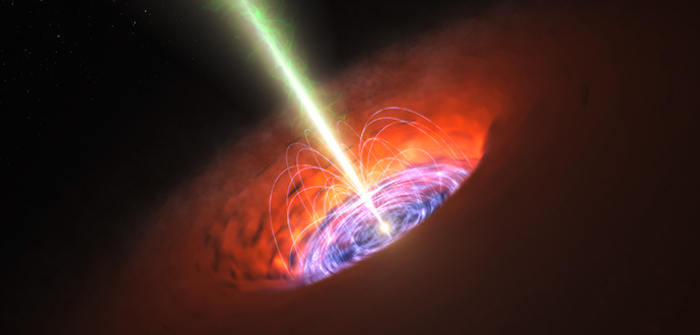.

Astronomers from Chalmers have used the giant telescope Alma to reveal an extremely powerful magnetic field very close to a supermassive black hole in a distant galaxy. The results appear in the 17 April 2015 issue of the journal Science.
A team of five astronomers from Chalmers have revealed an extremely powerful magnetic field, beyond anything previously detected in the core of a galaxy, very close to the event horizon of a supermassive black hole. This new observation helps scientists to understand the structure and formation of these massive inhabitants of the centres of galaxies, and the twin high-speed jets of plasma they frequently eject from their poles.
Up to now only weak magnetic fields far from black holes — several light-years away — had been probed. In this study, however, astronomers from Chalmers University of Technology and Onsala Space Observatory in Sweden have now used Alma to detect signals directly related to a strong magnetic field very close to the event horizon of the supermassive black hole in a distant galaxy named PKS 1830-211. This magnetic field is located precisely at the place where matter is suddenly boosted away from the black hole in the form of a jet.
The team measured the strength of the magnetic field by studying the way in which light was polarised, as it moved away from the black hole.
“Polarisation is an important property of light and is much used in daily life, for example in sun glasses or 3D glasses at the cinema,” says Ivan Marti-Vidal, lead author of this work. “When produced naturally, polarisation can be used to measure magnetic fields, since light changes its polarisation when it travels through a magnetised medium. In this case, the light that we detected with Alma had been travelling through material very close to the black hole, a place full of highly magnetised plasma.”
The astronomers applied a new analysis technique that they had developed to the Alma data and found that the direction of polarisation of the radiation coming from the centre of PKS 1830-211 had rotated.
Magnetic fields introduce Faraday rotation, which makes the polarisation rotate in different ways at different wavelengths. The way in which this rotation depends on the wavelength tells us about the magnetic field in the region. The Alma observations were at an effective wavelength of about 0.3 millimetres, the shortest wavelengths ever used in this kind of study. This allows the regions very close to the central black hole to be probed. Earlier investigations were at much longer radio wavelengths. Only light of millimetre wavelengths can escape from the region very close to the black hole; longer wavelength radiation is absorbed.
"We have found clear signals of polarisation rotation that are hundreds of times higher than the highest ever found in the Universe," says Sebastien Muller, co-author of the paper. "Our discovery is a giant leap in terms of observing frequency, thanks to the use of ALMA, and in terms of distance to the black hole where the magnetic field has been probed — of the order of only a few light-days from the event horizon. These results, and future studies, will help us understand what is really going on in the immediate vicinity of supermassive black holes.”
Quelle: CHALMERS UNIVERSITY OF TECHNOLOGY - SE-412 96 GOTHENBURG, SWEDEN
4903 Views
